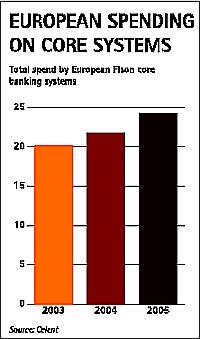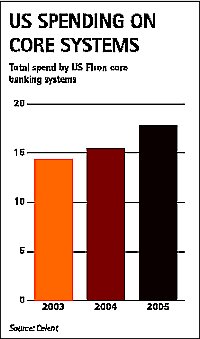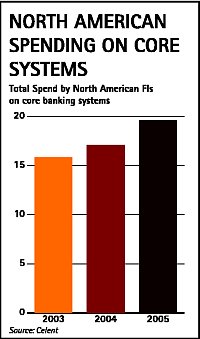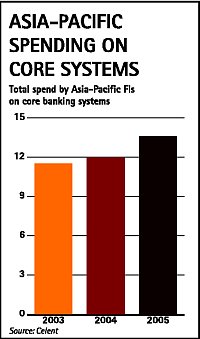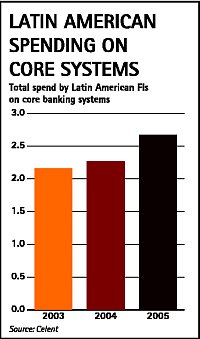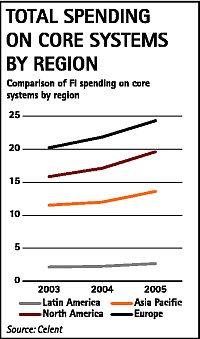The banking industry worldwide appears to be nearing a time when core systems will be replaced. But, says Christine Barry, the methods used may be very different.
New banking requirements and customer demands are challenging traditional banking practices. This environment has put added strain on the antiquated core systems found in many large banks around the globe. Most of these systems have been in place since the 1960s and 1970s, built in-house using the technology of the day. As a result, they are costly to maintain, inflexible and operate in closed environments, making communication with other systems and completion of simple transactions a difficult task.
Given these factors, coupled with bottom-line pressures, a growing number of banks are considering replacing existing core systems with next generation vendor solutions. This shift to vendor solutions not only represents a significant move from the more traditional homegrown solutions, but also promises greater speed to market, lower cost, advanced functionalities and higher success rates.
Replacement strategies are also beginning to stray from the more traditional ‘big bang’ approach in which a full replacement is completed at one time. This approach has not met with much success and therefore is not likely to be the method of choice for most large institutions. This method is better suited to smaller financial firms with less complex needs and architectures. The risks inherent in this method are extremely high and customers may be alienated if the migration is not completed flawlessly. On the positive side, however, this migration method is likely to be completed in the least amount of time.
Many large banks today are instead taking more of a phased approach. With this approach, solutions are replaced on either a region-by-region basis or a product line-by-product line.
Proponents of the regional approach include many global institutions that, as a result of constant upgrades and adaptations to meet the varied needs of different regions, are running as many as 120 different core systems. The regional migration approach is a phased one in which an institution migrates one region’s system at a time. Smaller, foreign branches are typical starting points; larger regions replace their systems in later phases. Citibank and Sumitomo Mitsui are examples of banks that have taken this approach.
The rationale for selecting this method is that its step-by-step approach reduces risks from the technology and project points of view. Product sets also vary by region making this approach a logical one for institutions with several foreign branches.
The other approach to replacement, product-line migration, addresses the short-term issues which lines of business often have by tackling their problems first as opposed to the region or branch as a whole. It delivers short-term return for the business line as well as a long-term solution for the bank as the solution is scalable and can often be rolled out to other business lines when the bank is ready. Scotiabank is currently using this method for its global mortgage group which, prior to rollout, had not been able to function as it should given its previous technology. Arab Banking Corporation is also using this method to overhaul its corporate banking application infrastructure.
Replacement and regional trends
The urgency for core system replacement differs from bank to bank, with many continuing to deny the need for new systems, fearing the costs and associated risks. Replacement projects will therefore be slow to take off with only a handful of the largest global banks with projects now in place. Regional trends will also be a factor. Celent forecasts that European, north American, Asia Pacific and Latin American banks will each spend $24bn, $19.6bn, $13.6bn and $2.67bn respectively on core systems by 2005.
Europe leads the way
The European banks thus far appear to be moving fastest with core systems replacement. This is due, in part, to the fact that most of their technology decisions are made by members of IT departments as opposed to business strategists, who are the typical decision-makers in other parts of the world. These IT staff members are likely to place greater weight on deploying cutting-edge technologies and have a better understanding the cost and productivity benefits of such technologies, as well as the urgency of the need to replace older systems.
Greater system flexibility has also become increasingly important for banks in this part of the world as a result of the EU and greater use of the euro. These factors have made replacement of core systems more urgent at European banks than at banks in other parts of the world. Implementing changes of this type poses too great a challenge to most older systems. Finally, because many banks, given the single European market, are also moving toward a single hub to handle all European transactions, a single system is needed to track transactions for the region.
The European financial services industry, like others around the globe, has been negatively affected by poor economic conditions. Despite this, financial institutions in Europe are expected to spend more on core banking systems than any other region in the world over the next few years.
North American priorities
Core replacement remains a moderate priority for many US and Canadian banks, but is expected to become a high priority as new efficiencies become harder to identify. north American bank customers demand high levels of customer service, making antiquated transaction-based systems misaligned with current customer-centric strategies. Transaction-based systems make it difficult to extract customer data to help banks better identify cross-selling opportunities and serve their customers.
Reluctance exists in the region to replace existing mainframe systems because of the large costs associated with such initiatives. That said, the consolidation that took place, especially in the US, during the 1990s left many banks to deal with the inefficiency of having multiple systems running simultaneously. As banks are forced to cut costs, a large number will look to core replacement as a way to consolidate systems onto a single platform and eliminate multiple licence fees and process redundancies. To date, only a handful of the largest north American banks have begun replacement projects including Citibank, Bank of America and Scotiabank.
Most large north American banks continue to rely on mainframe technologies, particularly their proven scalability, but Celent is beginning to see a slow movement toward Unix in this region. Many overseas vendors have also set their sights on entering this market with their next-generation solutions. The US market poses a particular challenge for foreign solutions providers, however, as it favours domestic players – very few banks have taken a chance with a non-US vendor.
Lower spend in Asia Pacific
While demand exists for new core banking systems in the Asia Pacific region, the sense of urgency is not comparable to what we are seeing in other parts of the world where activity among the largest banks has been much greater. Countries in this region have very large populations but these countries are not generally faced with the same complexity and volumes of transactions as in other parts of the world, lessening their need for more advanced systems, at least in the short term. This region has been hit hard by the current recession as well as by the effects of bad loans and corporate corruption. Much of the financial services industry is being restructured. While spending on IT continues to grow, it is doing so at a much slower rate.
In Japan, IT spending is heavily weighted toward the largest banks. The group of six City banks account for over half of all IT spending in the Japanese banking industry. This limits the target market for solution providers in the country as well as the potential number of core replacements.
Solution providers are seeing a lot of growth potential in countries such as India, Singapore and China. For instance, now that China has become a member of the WTO, it is moving ahead quickly from a technology standpoint. As foreign companies increasingly enter this market, there will be a growing need for new technologies. This region has an advantage over other regions of the world. Because it is starting from scratch, many of the challenges associated with replacement of older systems and with resistance from users comfortable with older technologies are avoided. For these reasons, core systems spending will be less in Asia Pacific than in Europe and north America.
Latin America market size
Similar to other parts of the world, Latin American banks have experienced a great deal of consolidation over the last few years. This market has seen the entrance of many large foreign banks such as Citibank and Bank Boston from the US. In addition, European banks, especially Spanish ones, are slowly beginning to dominate the space, increasing competition among smaller local institutions. These smaller banks, in many cases, are fighting to remain competitive and to operate as efficiently as possible. As a result, many do not have the budgets to take on costly initiatives such as core system replacement. For these banks, the more common and affordable option is to deploy middleware layers and focus on improving the integration of existing systems and channels. Most of the technology spending in this region will be done by the larger multinational banks. These banks have money to spend and they are already using more advanced technologies in their home branches. With mostly smaller local banks and a new influx of foreign banks, the structure of this region will keep technology investments, at least in the short term, relatively low. Most spending will occur in the three largest economic markets: Brazil, Mexico and Argentina. Compared to banks in other regions of the world, Latin American banks on average spend far less on new technologies, with an even higher percentage of monies going toward maintenance of existing systems than is the norm. Spending remains low despite the increases which came as a result of the deregulation and privatisation efforts in the telecommunications and financial services industries during the late 1990s.
Legacy of the 1960s
Investing in new core systems is not yet a priority for most banks, but will become increasingly important as a growing number of banks begin to realise that their antiquated systems are no longer adequately meeting their needs. The market is already beginning to see signs of change as a handful of the world’s largest institutions have begun to migrate from mainframe systems built during the 1960s and 1970s to more modern, next-generation solutions.
Celent believes it will become almost impossible for a large financial institution to remain competitive without replacing its core system. While transactions have not changed much over the last few decades, external requirements have. Customer expectations are greater, as is the need for information. Older systems face integration issues and making changes within them is, at times, impossible. Financial institutions also face external pressures, like Basel II, which have placed new requirements on their already overburdened systems. Small and medium-sized banks, whose need to replace core systems may be less urgent, are also likely to replace their older systems with more modern ones better aligned with their more customer-centric strategies.
In addition to an increasing number of system replacements, several other trends are expected to shape the industry over the next few years. These trends include: a gradual movement away from mainframe systems, an increasing number of vendor-built solution deployments, a shift toward browser-based solutions and a greater focus on the US market.
As the world’s largest institutions lead the way with core system replacement, their implementations are being closely observed by other banks and their success is likely to lead to greater momentum within the industry. Those that have taken on the these projects have already begun to reap the benefits of greater efficiency, easier access to information and the ability to add new applications without the fear of system crashes. While the costs as well as the risks are high, these banks are confident that the ultimate benefits will be far greater.
Christine Barry is an analyst, banking group, at Celent Communications



